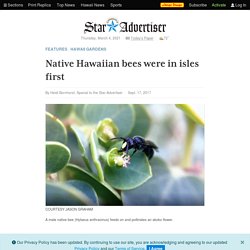

Invasive ants threaten endangered bees in Hawaii. Native Ecosystems Protection & Management. Native Hawaiian yellow-faced bees in the genus Hylaeus (Hymenoptera: Colletidae) have adapted to a wide array of habitat types ranging from coastal strand to high elevation wet forests.

These solitary bees are important pollinators of native Hawaiian plants and trees in every environment in which they occur. Early naturalist R.C.L. Perkins described Hawaiian yellow-faced bees as “almost the most ubiquitous of any Hawaiian insects” during surveys he conducted in Hawai‘i during the late 19th century. However, like much of the native biota, yellow-faced bees, once so abundant across the Hawaiian Islands, have experienced dramatic range reductions, population declines and possibly extinctions over the last 100 years. As a consequence, thirty-three yellow-faced bee species were placed on the U.S. Native Hawaiian bees were in isles first. Mahalo for supporting Honolulu Star-Advertiser.

Enjoy this free story! Native Hawaiian bees pollinated plants here before honeybees were introduced in 1857. Jason Graham of the Department of Plant and Environmental Protection Sciences at the University of Hawaii at Manoa has been working with students to kokua these rare and beneficial native insects. The same issues that plague honeybees trouble our native bees, too. Systemic use of insecticides is one problem for bees and other beneficial pollinators — the “good” bugs on our planet.